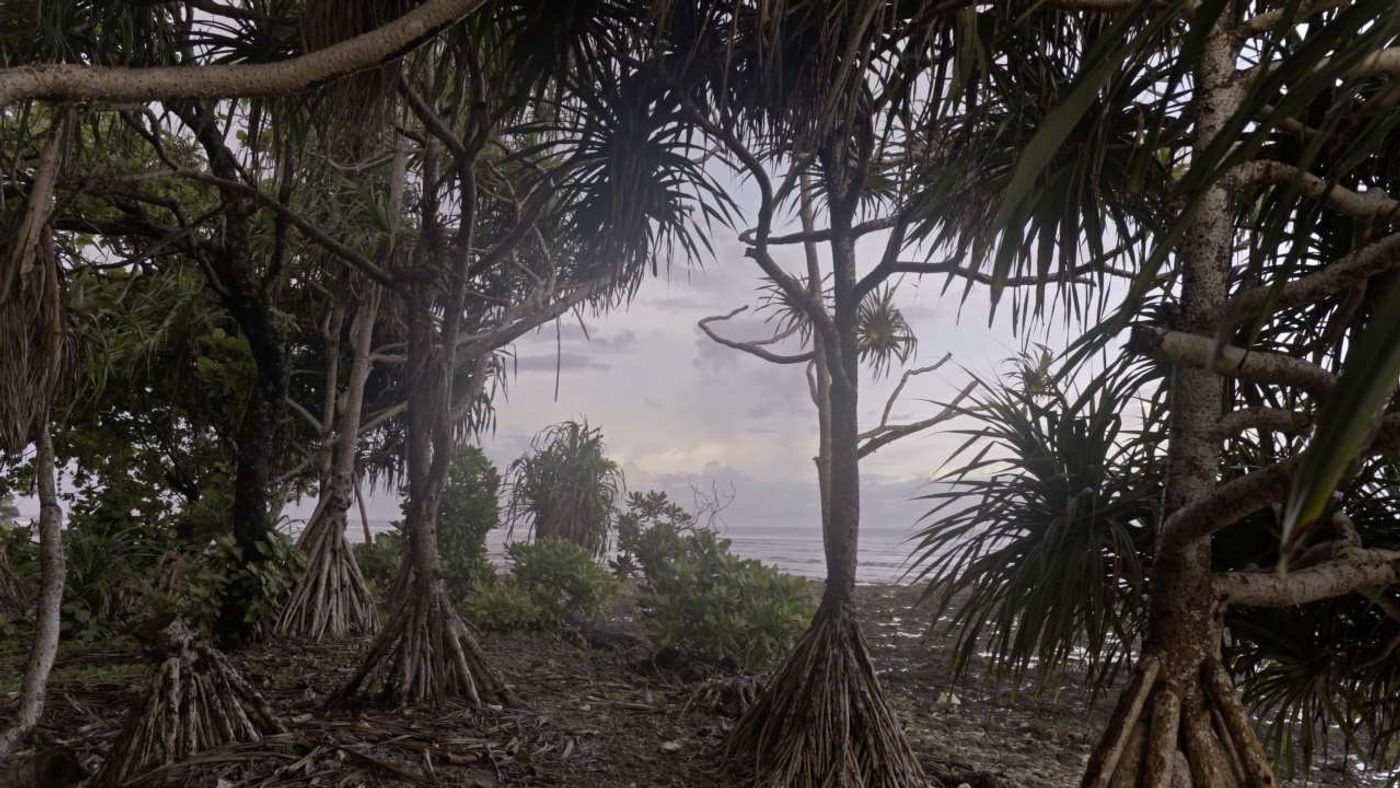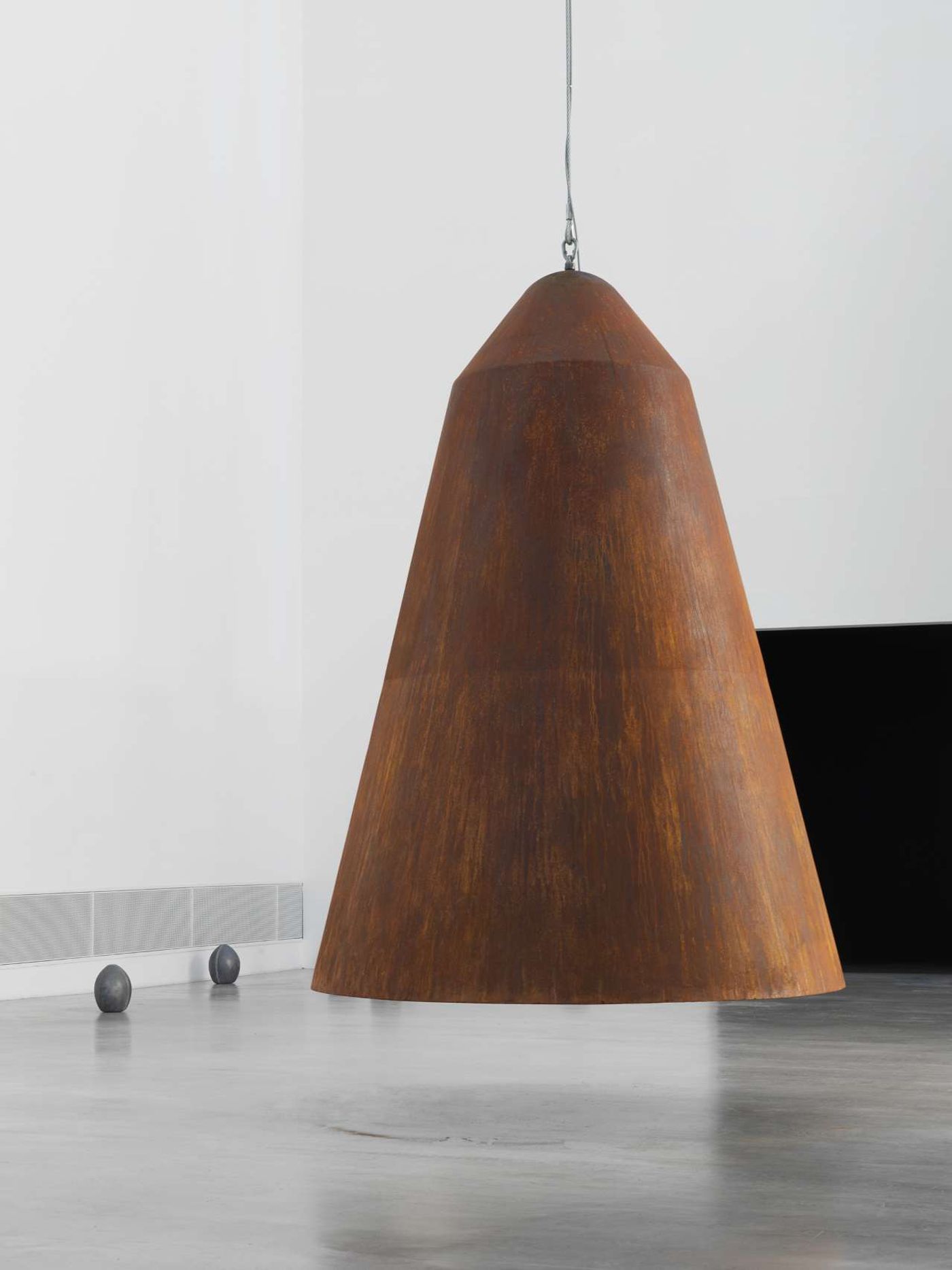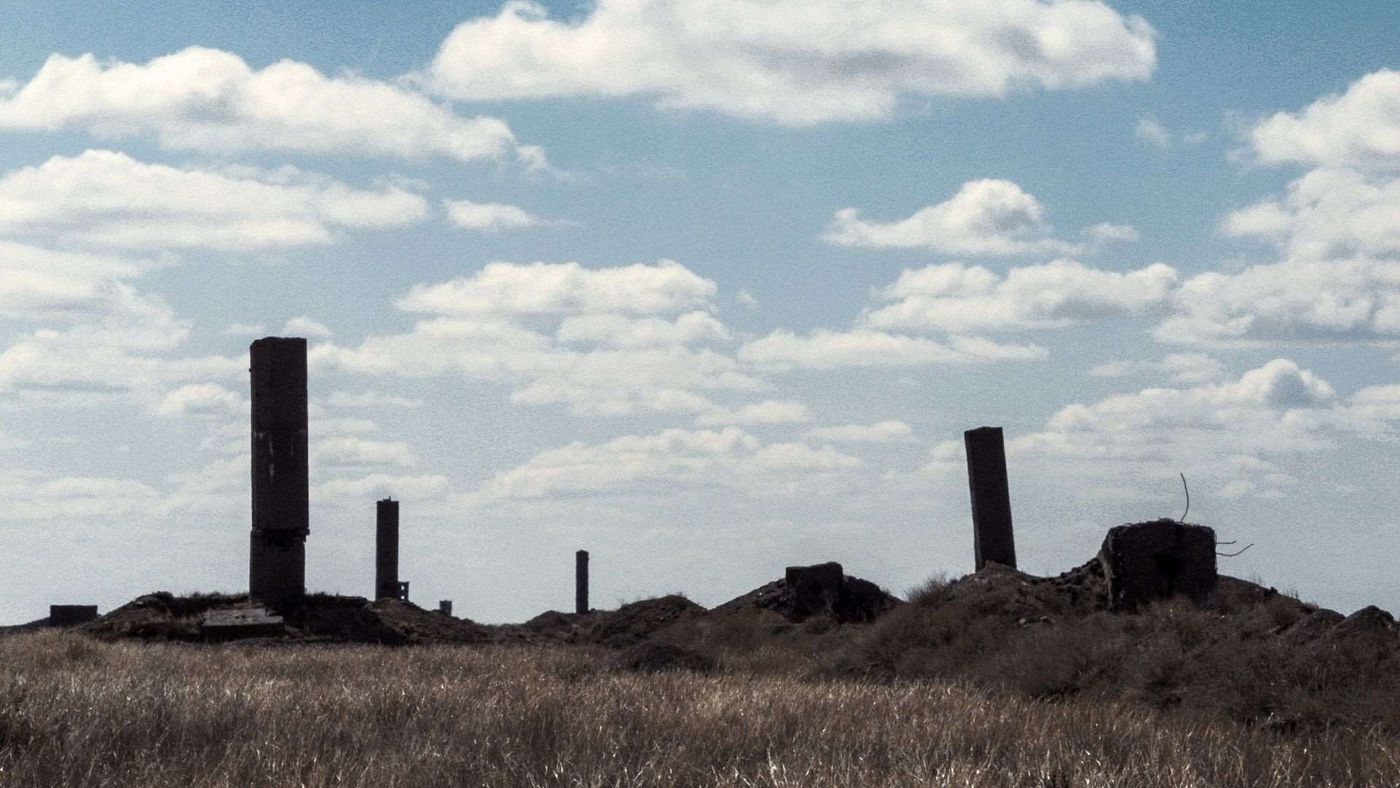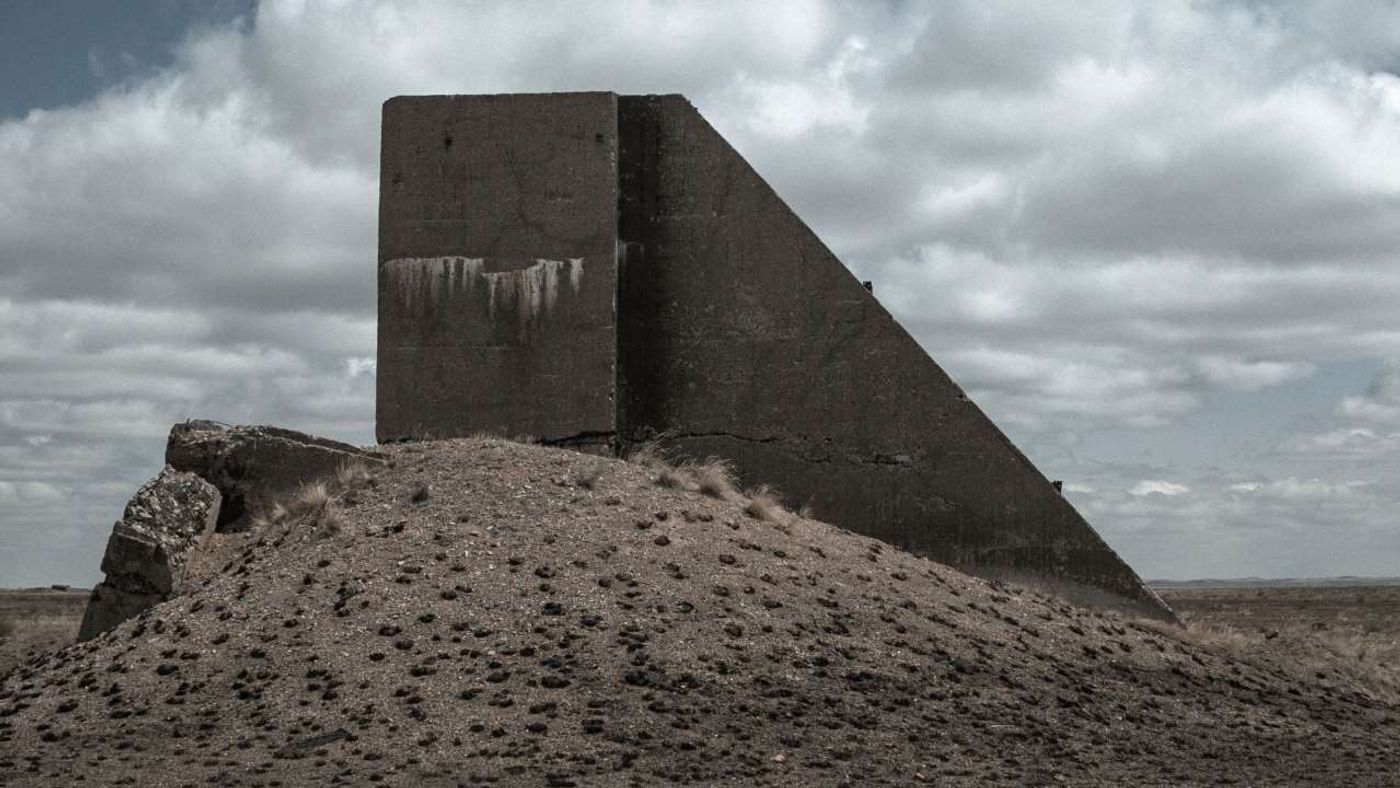
Julian Charrière: All We Ever Wanted Was Everything and Everywhere
Words by Eric David
Location
Bologna, Italy
Julian Charrière: All We Ever Wanted Was Everything and Everywhere
Words by Eric David
Bologna, Italy
Bologna, Italy
Location
Visitors entering the seductively titled 'All We Ever Wanted Was Everything and Everywhere', the solo exhibition from French-Swiss, Berlin-based artist Julian Charrière at Museo d’Arte Moderna di Bologna (MAMbo), are immediately transported to a remote atoll in the Pacific Ocean. And yet, instead of a Garden of Eden, or an unspoilt tourist paradise that the exhibition’s title and exotic destination suggest, what they encounter is a post-apocalyptic world where humankind is irrevocably altering the natural environment. From Bikini Atoll, in the Marshall Islands, where the US detonated 23 nuclear devices 70 years ago, to Semipalatinsk, Kazakhstan, a former Soviet nuclear test site, to dark aquatic caves in Yucatan, Mexico, the remote places where Charrière has travelled to, explored, and documented, reveal the perennial fractures between human civilization and nature. It would be wrong though to assume that the exhibition is simply an environmental call to arms. Bridging the realms of environmental science and cultural history, Charrière’s work not only draws on humankind’s attempts to dominate the environment but also investigates ideas about ephemerality, the passage of time and the cultural projections that change the meaning and perception of a place.

Julian Charrière, All We Ever Wanted Was Everything and Everywhere, installation view. MAMbo – Museo d’Arte Moderna di Bologna. Photo by Giorgio Bianchi, Comune di Bologna.

Julian Charrière, All We Ever Wanted Was Everything and Everywhere, installation view. MAMbo – Museo d’Arte Moderna di Bologna. Photo by Giorgio Bianchi, Comune di Bologna.

Julian Charrière, All We Ever Wanted Was Everything and Everywhere, installation view. MAMbo – Museo d’Arte Moderna di Bologna. Photo by Giorgio Bianchi, Comune di Bologna.

Julian Charrière, All We Ever Wanted Was Everything and Everywhere, installation view. MAMbo – Museo d’Arte Moderna di Bologna. Photo by Giorgio Bianchi, Comune di Bologna.
Housed in MAMbo’s Sala delle Ciminiere, the expansive ground floor galleries of what once was an industrial bakery, the exhibition includes a wide selection of works such as photographs, installations, sculptures and videos that question the interaction between anthropogenic and natural forces in transforming the planet. Charrière’s projects often stem from fieldwork in remote locations where, like an archaeologist, the artist explores past events to understand those yet to come while reflecting on the present. Curated by Lorenzo Balbi, the exhibition retraces the artist’s expeditions to take visitors along on a journey that touches upon the history of science, the development of media culture, the romantic vision of exploration and the modern ecological crisis.
The first stop on this journey is Bikini Atoll in the Pacific Ocean, the location of a barrage of nuclear device detonations that the US executed between 1946 and 1958 with a combined fission yield of 42.2 megatons – for reference, the atomic bomb dropped on Hiroshima released just 15 kilotons or 0.015 megatons. Charrière invites visitors through several pieces to explore what remains of those tests, above and below the sea, revealing an unsettling legacy of unintended monuments.

Julian Charrière, Iroojrilik, 2016. 4K color video with stereo sound, sound by Edward Davenport, 21’3’’ (loop). Courtesy the artist; DITTRICH & SCHLECHTRIEM, Berlin; Galerie Tschudi, Zuoz; Sean Kelly, New York; Sies+Höke, Düsseldorf.

Julian Charrière, Iroojrilik, 2016. 4K color video with stereo sound, sound by Edward Davenport, 21’3’’ (loop). Courtesy the artist; DITTRICH & SCHLECHTRIEM, Berlin; Galerie Tschudi, Zuoz; Sean Kelly, New York; Sies+Höke, Düsseldorf.

Julian Charrière, All We Ever Wanted Was Everything and Everywhere, installation view. MAMbo – Museo d’Arte Moderna di Bologna. Photo by Giorgio Bianchi, Comune di Bologna.

Julian Charrière, All We Ever Wanted Was Everything and Everywhere, installation view. MAMbo – Museo d’Arte Moderna di Bologna. Photo by Giorgio Bianchi, Comune di Bologna.

Julian Charrière, As We Used to Float, 2018. Single-channel video installation, full-HD color video with stereo sound, 6’15” (loop). Courtesy the artist; DITTRICH & SCHLECHTRIEM, Berlin; Galerie Tschudi, Zuoz; Sean Kelly, New York; Sies+Höke, Düsseldorf.

Julian Charrière, As We Used to Float, 2018. Single-channel video installation, full-HD color video with stereo sound, 6’15” (loop). Courtesy the artist; DITTRICH & SCHLECHTRIEM, Berlin; Galerie Tschudi, Zuoz; Sean Kelly, New York; Sies+Höke, Düsseldorf.
During his trip to Bikini, Charrière spent weeks filming an underwater graveyard sixty-five metres below the surface known as the Ghost Fleet. Comprised of hundreds of decommissioned ships that the Americans left behind, the post-apocalyptic site is revealed in all its ghostly glory in the enormous video installation ‘As We Used to Float’, which tracks ad infinitum in a single camera sequence, a giant sunken propeller swathed in seaweed, and in ‘Iroojrilik’, a video that overlaps the monstrous wrecks at the bottom of the sea with the abandoned concrete structures on the atoll, psychedelically mixed with sunsets and sunrises.
As impressive is the installation ‘All We Ever Wanted Was Everything and Everywhere’, which gives its name to the exhibition. Inspired by his underwater exploration, a gigantic diving bell, one of humankind’s earliest contraptions for exploring the sea, hangs from a pulley on the roof, balanced by a chandelier made of plastic bags filled with Pacific sea water in a precarious equilibrium between human ingenuity and the forces of nature. Standing near the diving bell, visitors are entranced by the hypnotic sound of the slowed, rhythmic breath of a diver underwater, an allusion to the "oceanic feeling", a phrase coined by Romain Rolland in a letter to Sigmund Freud to refer to the sensation of being one with the universe. Science and religion or spirituality, Charrière seems to be saying, are the two driving forces behind man’s desire to exert control over his environment, both of which the artist implies are sinking humankind deeper into the abyss.

Julian Charrière, All We Ever Wanted Was Everything and Everywhere, 2018. Diving bell made out of steel with stereo sound system, stainless steel structure, plastic bags, Pacific sea water, pulley-system, steel wire ropes. Courtesy the artist; DITTRICH & SCHLECHTRIEM, Berlin; Galerie Tschudi, Zuoz; Sean Kelly, New York; Sies+Höke, Düsseldorf.

Julian Charrière, All We Ever Wanted Was Everything and Everywhere, installation view. MAMbo – Museo d’Arte Moderna di Bologna. Photo by Giorgio Bianchi, Comune di Bologna.

Julian Charrière, All We Ever Wanted Was Everything and Everywhere, installation view. MAMbo – Museo d’Arte Moderna di Bologna. Photo by Giorgio Bianchi, Comune di Bologna.

Julian Charrière, Pacific Fiction, 2016. Coconuts in lead sarcophagi, steel frames. Courtesy the artist; Petra Maria Singh, New York; Galerie Tschudi, Zuoz.

Julian Charrière, Tewa - First Light, 2016. Large format color photograph, double exposed through radioactive material, archival pigment print on Hahnemühle Photo Rag. Collection LAB Partners, Salt Lake City, Utah.

Julian Charrière, All We Ever Wanted Was Everything and Everywhere, installation view. MAMbo – Museo d’Arte Moderna di Bologna. Photo by Giorgio Bianchi, Comune di Bologna.

Julian Charrière, All We Ever Wanted Was Everything and Everywhere, installation view. MAMbo – Museo d’Arte Moderna di Bologna. Photo by Giorgio Bianchi, Comune di Bologna.
Scattered all around the floor below the diving bell are coconuts encased in lead sarcophagi, occasionally forming pyramid-like piles. Titled ‘Pacific Fiction’, the installation takes its cue from a local myth that has a mother giving birth to a coconut in order to supply her people with sustenance, tools and clothing – the irony being that Charrière’s encased coconuts can be used for neither nourishment nor plant reproduction.
The same can be said for ‘Lost at Sea – Pikini Fragment’, two sculptures made from mutated coconuts found at the atoll which are displayed further on in the exhibition, inside glass vitrines on stainless steel pedestals. Alongside these post-apocalyptic artefacts are a series of photographs named ‘Tewa - First Light’ that the artist took on Bikini whose idyllic iconography of palm trees, sandy beaches and sunsets is eerily disturbed by a luminous haze, the result of exposing the film stock to radioactive material.

Julian Charrière, All We Ever Wanted Was Everything and Everywhere, installation view. MAMbo – Museo d’Arte Moderna di Bologna. Photo by Giorgio Bianchi, Comune di Bologna.

Julian Charrière, Lost at Sea - Pikini-Fragment, 2016. Found bikinian coconut, high-polished stainless steel pedestal, coral sand, white glass vitrine. Courtesy the artist; DITTRICH & SCHLECHTRIEM, Berlin; Galerie Tschudi, Zuoz.

Julian Charrière, All We Ever Wanted Was Everything and Everywhere, installation view. MAMbo – Museo d’Arte Moderna di Bologna. Photo by Giorgio Bianchi, Comune di Bologna.

Julian Charrière, Somewhere, 2014. Full-HD color video with stereo sound, sound by Edward Davenport, 16’24”. Courtesy the artist; DITTRICH & SCHLECHTRIEM, Berlin; Galerie Tschudi, Zuoz; Sean Kelly, New York; Sies+Höke, Düsseldorf.

Julian Charrière, Somewhere, 2014. Full-HD color video with stereo sound, sound by Edward Davenport, 16’24”. Courtesy the artist; DITTRICH & SCHLECHTRIEM, Berlin; Galerie Tschudi, Zuoz; Sean Kelly, New York; Sies+Höke, Düsseldorf.

Julian Charrière, All We Ever Wanted Was Everything and Everywhere, installation view. MAMbo – Museo d’Arte Moderna di Bologna. Photo by Giorgio Bianchi, Comune di Bologna.

Julian Charrière, All We Ever Wanted Was Everything and Everywhere, installation view. MAMbo – Museo d’Arte Moderna di Bologna. Photo by Giorgio Bianchi, Comune di Bologna.

Julian Charrière, All We Ever Wanted Was Everything and Everywhere, installation view. MAMbo – Museo d’Arte Moderna di Bologna. Photo by Giorgio Bianchi, Comune di Bologna.
From America’s Pacific nuclear test site to Semipalatinsk Test Site in Kazakhstan – the flip side of the Cold War nuclear arms race – where the Soviet Union conducted 456 atmospheric and underground nuclear tests, nearly one-quarter of all such tests ever conducted in the world. Once again, Charrière has meticulously and evocatively documented the site, also known as "The Polygon", through a series of photographs titled 'Polygon', which he has manipulated by exposing the film negative to contaminated soil. The result are eerie black and white pictures whose ghostly traces attest to the destructive legacy of radiation persisting decades after the site was closed down, as is ‘Somewhere’, a video that the artist shot during the short times he was allowed on the contaminated site.

Julian Charrière, All We Ever Wanted Was Everything and Everywhere, installation view. MAMbo – Museo d’Arte Moderna di Bologna. Photo by Giorgio Bianchi, Comune di Bologna.

Julian Charrière, Polygon XII, 2014. Medium format black-and-white photograph, double exposed through radioactive material, archival pigment print on Hahnemühle Photo Rag Baryta, lead tube containing photographic negative and radioactive specimen from test site in sealed test tube. Courtesy DITTRICH & SCHLECHTRIEM, Berlin.

Julian Charrière, Polygon X, 2014. Medium format black-and-white photograph, double exposed through radioactive material, archival pigment print on Hahnemühle Photo Rag Baryta, lead tube containing photographic negative and radioactive specimen from test site in sealed test tube. Courtesy DITTRICH & SCHLECHTRIEM, Berlin.

Julian Charrière, Polygon XXIX, 2014. Medium format black-and-white photograph, double exposed through radioactive material, archival pigment print on Hahnemühle Photo Rag Baryta. Private Collection, Switzerland.

Julian Charrière, All We Ever Wanted Was Everything and Everywhere, installation view. MAMbo – Museo d’Arte Moderna di Bologna. Photo by Giorgio Bianchi, Comune di Bologna.

Julian Charrière, Savannah Shed, 2016. Concrete, steel, detector shield, scintillation spectrometer, caiman. Private Collection, Switzerland.
In dialogue with the phantom structures in Kazakhstan are two additional installations that also evoke mythological edifices. ‘Savannah Shed’ is an artistic reconstruction of the ad-hoc contraption American scientists came up with in 1964 to measure the level of radiation of an alligator following an accident at the Savannah River Site nuclear reservation in South Carolina. ‘Somehow They Never Stop Doing What They Always Did’ is a series of intricate sculptures made from small plaster bricks, fructose and lactose, which have been moistened with water from major rivers such as the Nile, the Euphrates and the Mekong. Just as the ancient civilisations that these rivers gave birth to eventually declined, the sculpture’s moisture will inevitably lead to their decay and collapse. From the Tower of Babel, to the Pyramids, to the Hanging Gardens of Babylon, to the megacity of Angkor, all the way to the concrete landmarks of the nuclear age, Charrière traces an unbroken line of human follies, destined to fall apart, no matter the cultural, religious or scientific agenda behind them.

Julian Charrière, All We Ever Wanted Was Everything and Everywhere, installation view. MAMbo – Museo d’Arte Moderna di Bologna. Photo by Giorgio Bianchi, Comune di Bologna.

Julian Charrière, All We Ever Wanted Was Everything and Everywhere, installation view. MAMbo – Museo d’Arte Moderna di Bologna. Photo by Giorgio Bianchi, Comune di Bologna.

Julian Charrière, Somehow They Never Stop Doing What They Always Did, 2019. Nutrient enriched plaster, water specimens from major international rivers, climate-controlled stainless steel showcases with double glazing. Courtesy the artist; DITTRICH & SCHLECHTRIEM, Berlin; Galerie Tschudi, Zuoz; Sean Kelly, New York; Sies+Höke, Düsseldorf.

Julian Charrière, All We Ever Wanted Was Everything and Everywhere, installation view. MAMbo – Museo d’Arte Moderna di Bologna. Photo by Giorgio Bianchi, Comune di Bologna.

Julian Charrière, All We Ever Wanted Was Everything and Everywhere, installation view. MAMbo – Museo d’Arte Moderna di Bologna. Photo by Giorgio Bianchi, Comune di Bologna.

Julian Charrière, All We Ever Wanted Was Everything and Everywhere, installation view. MAMbo – Museo d’Arte Moderna di Bologna. Photo by Giorgio Bianchi, Comune di Bologna.

Julian Charrière, All We Ever Wanted Was Everything and Everywhere, installation view. MAMbo – Museo d’Arte Moderna di Bologna. Photo by Giorgio Bianchi, Comune di Bologna.
Further on, inspired by Buckminster Fuller’s writings, ‘We Are All Astronauts’ is a set of suspended globes manufactured between 1890 and 2011 whose geographic markings the artist has singlehandedly rubbed off using a custom made sandpaper containing mineral samples from every country recognised by the United Nations. Underneath, a new map created as the pulverized markings fell off lyrically convey the futility of man’s attempt to establish fixed boundaries, as well as the inevitability of global transformation, either by natural or man-made phenomena.

Julian Charrière, All We Ever Wanted Was Everything and Everywhere, installation view. MAMbo – Museo d’Arte Moderna di Bologna. Photo by Giorgio Bianchi, Comune di Bologna.

Julian Charrière, We Are All Astronauts, 2013. 11 found globes made of glass, plastic and paper, abraded with international mineral sandpaper, suspended table top, dust from globes’surfaces. Courtesy the artist; DITTRICH & SCHLECHTRIEM, Berlin; Galerie Tschudi, Zuoz; Sean Kelly, New York; Sies+Höke, Düsseldorf.

Julian Charrière, All We Ever Wanted Was Everything and Everywhere, installation view. MAMbo – Museo d’Arte Moderna di Bologna. Photo by Giorgio Bianchi, Comune di Bologna.
The exhibition ends with two works of self-reflection, both depicting phantasmagorical, undersea realms. ‘Silent World’ consists of a ceiling-mounted projector beaming video footage of the sun’s rays breaking through the water’s surface onto a screen on the ground created by water vapours. Filmed with the camera underwater looking skywards, Charrière inverses the initial set up by pointing the projector downwards, in effect making the sun shine up from the deep. Just as deceptively orientated are the photographs in the series ‘Where Waters Meet’ which uncannily capture naked free-divers in the depths of aquatic caves in Yucatan, Mexico, known as "cenotes". Depicted in their descent disappearing into a thin, underwater cloud known as chemocline, viewers will have a hard time deciding if they are indeed descending or rising, the final decision saying more about their state of mind rather than the photographs.
Whereas the dystopic landscape of Bikini Atoll and "The Polygon" is the byproduct of the destructive power of man's nuclear experimentations, the wondrous geology of Yucatan's 'Ring of Cenotes' is a testament to something even more catastrophic, a meteor strike 66 million years ago which created an 180-kilometres-wide crater, initiated dramatic climate change and wiped out the dinosaurs. It's a potent reminder that for all the harm we are causing the planet, nature can always up the ante.
From confronting our own mortality to delving deep into our psyche, the divers’ descent into the abyss is of course brimming with metaphors. But perhaps the most apt interpretation is the one about being one with your surroundings, a concept that circles back to the “oceanic feeling” at the beginning of the exhibition. It’s another poignant reminder that there is an invisible line that connects all of humankind’s endeavours in their vainglorious aspiration to tame nature.
![Julian Charrière, Where Waters Meet [3.77 atmospheres], 2019. Archival pigment print on Hahnemühle Photo Rag Ultra Smooth. Courtesy the artist; DITTRICH & SCHLECHTRIEM, Berlin; Galerie Tschudi, Zuoz. Julian Charrière, Where Waters Meet [3.77 atmospheres], 2019. Archival pigment print on Hahnemühle Photo Rag Ultra Smooth. Courtesy the artist; DITTRICH & SCHLECHTRIEM, Berlin; Galerie Tschudi, Zuoz.](https://media.yatzer.com/s5_julian_charriere_all_we_ever_wanted_was_everything_and_everywhere_mambo_where_waters_meetyatzer-1-1400x1805.jpg)
Julian Charrière, Where Waters Meet [3.77 atmospheres], 2019. Archival pigment print on Hahnemühle Photo Rag Ultra Smooth. Courtesy the artist; DITTRICH & SCHLECHTRIEM, Berlin; Galerie Tschudi, Zuoz.

Julian Charrière, All We Ever Wanted Was Everything and Everywhere, installation view. MAMbo – Museo d’Arte Moderna di Bologna. Photo by Giorgio Bianchi, Comune di Bologna.

Julian Charrière, All We Ever Wanted Was Everything and Everywhere, installation view. MAMbo – Museo d’Arte Moderna di Bologna. Photo by Giorgio Bianchi, Comune di Bologna.

Julian Charrière, All We Ever Wanted Was Everything and Everywhere, installation view. MAMbo – Museo d’Arte Moderna di Bologna. Photo by Giorgio Bianchi, Comune di Bologna.